Abstract
Diagnostic advances have resulted in earlier and more frequent recognition of pituitary tumors. Pituitary tumors cause problems owing to the hormones they secrete or the effects of an expanding sellar mass--hypopituitarism, visual field abnormalities, and neurologic deficits. Prolactin-secreting tumors (prolactinomas), which cause amenorrhea, galactorrhea, and hypogonadism, constitute the most common type of primary pituitary tumors, followed by growth hormone-secreting tumors, which cause acromegaly, and corticotropin-secreting tumors, which cause Cushing's syndrome. Hypersecretion of thyroid-stimulating hormone, the gonadotrophins, or alpha-subunits is unusual. Nonfunctional tumors currently represent only 10% of all clinically diagnosed pituitary adenomas, and some of these are alpha-subunit-secreting adenomas. Insights into the pathogenesis and biologic behavior of these usually benign tumors have been gained from genetic studies. We review some of the recent advances and salient features of the diagnosis and management of pituitary tumors, including biochemical and radiologic diagnosis, transsphenoidal surgery, radiation therapy, and medical therapy. Each type of lesion requires a comprehensive but individualized treatment approach, and regardless of the mode of therapy, careful follow-up is essential.
Full text
PDF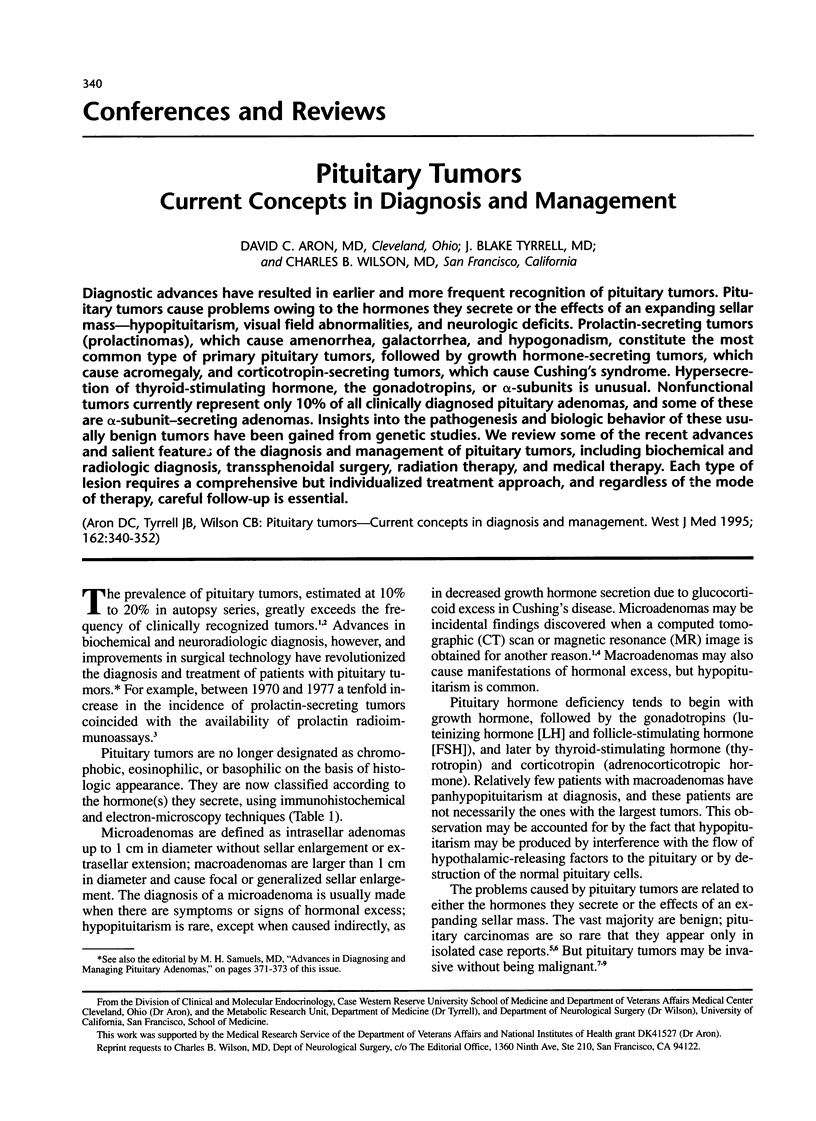
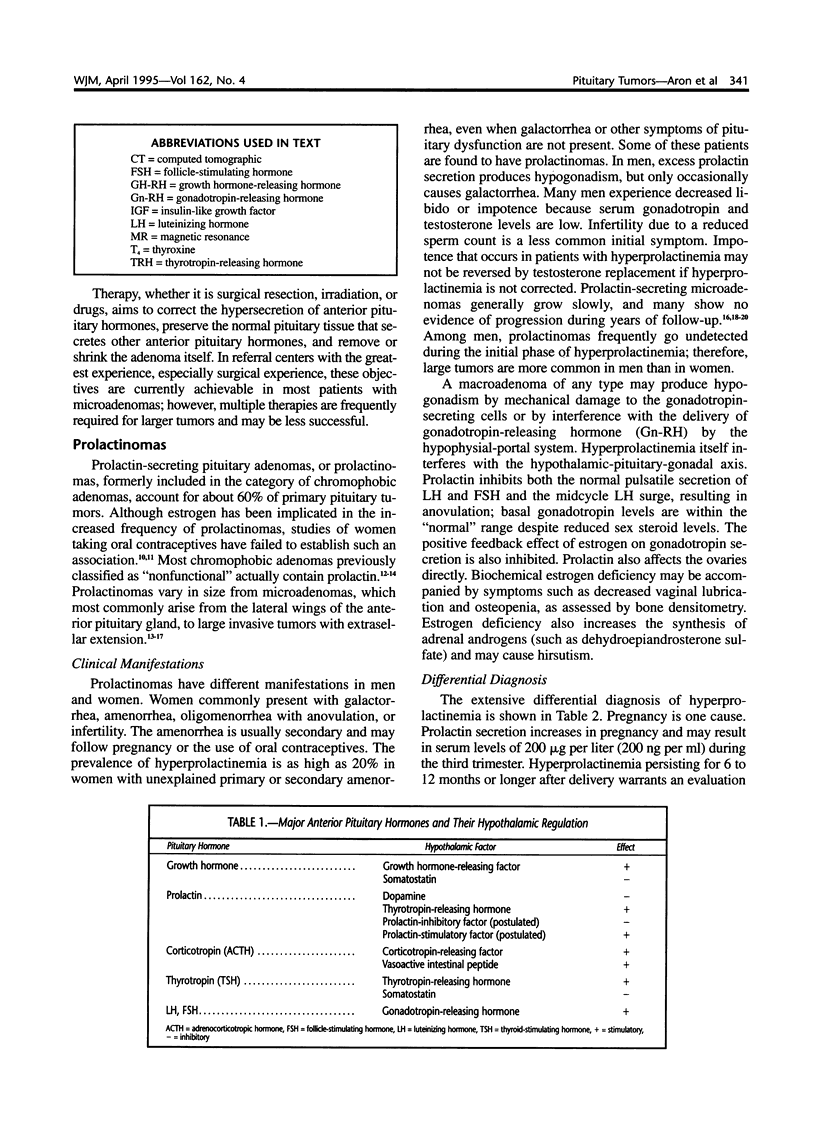
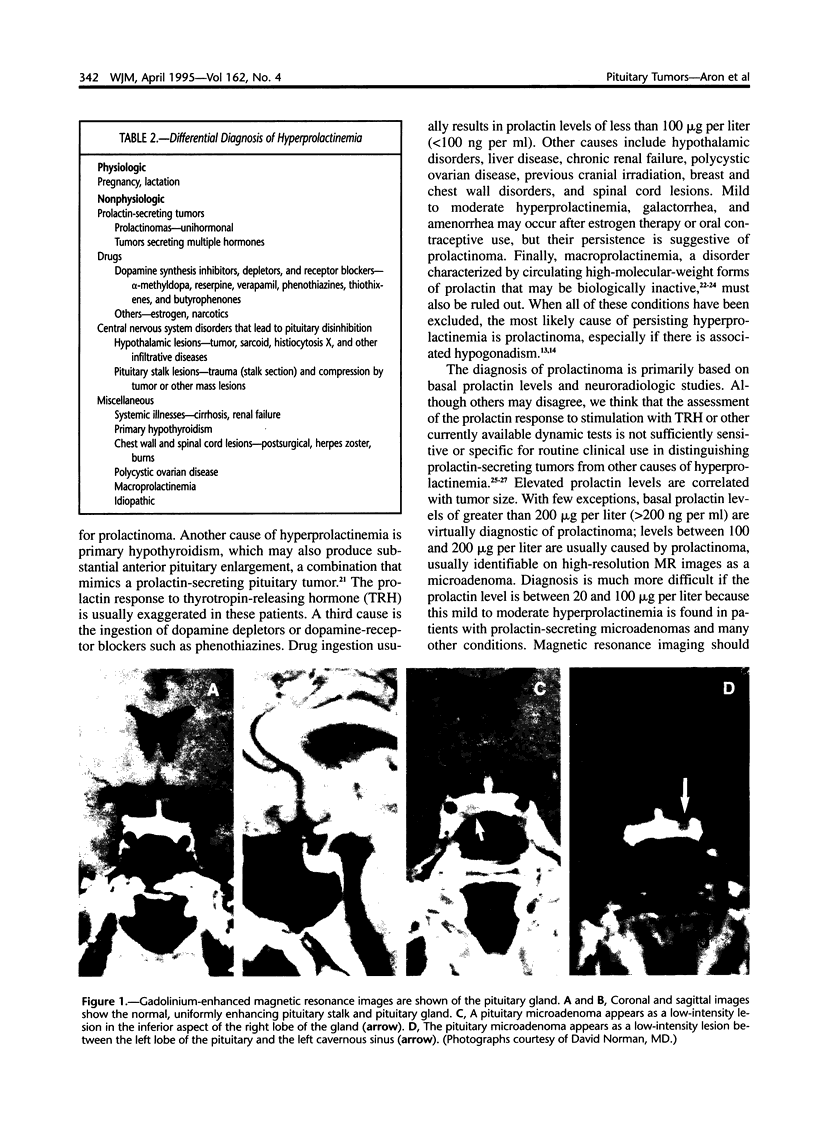
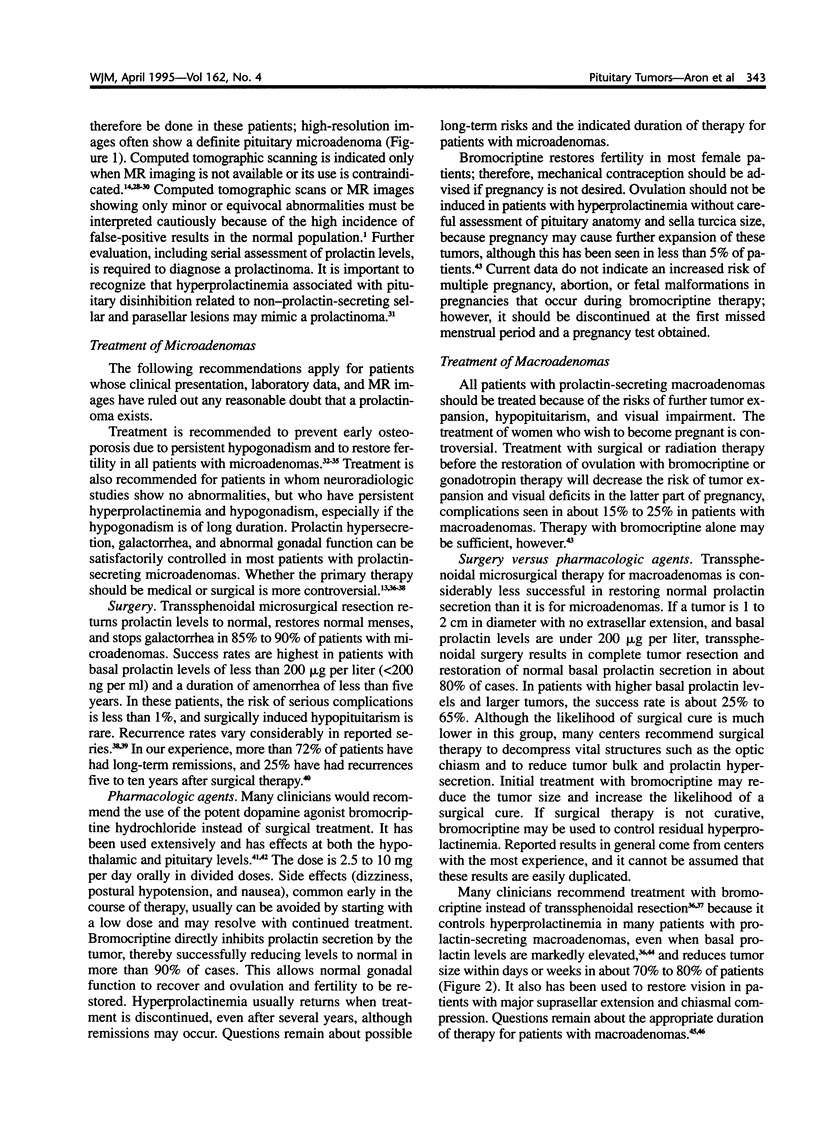
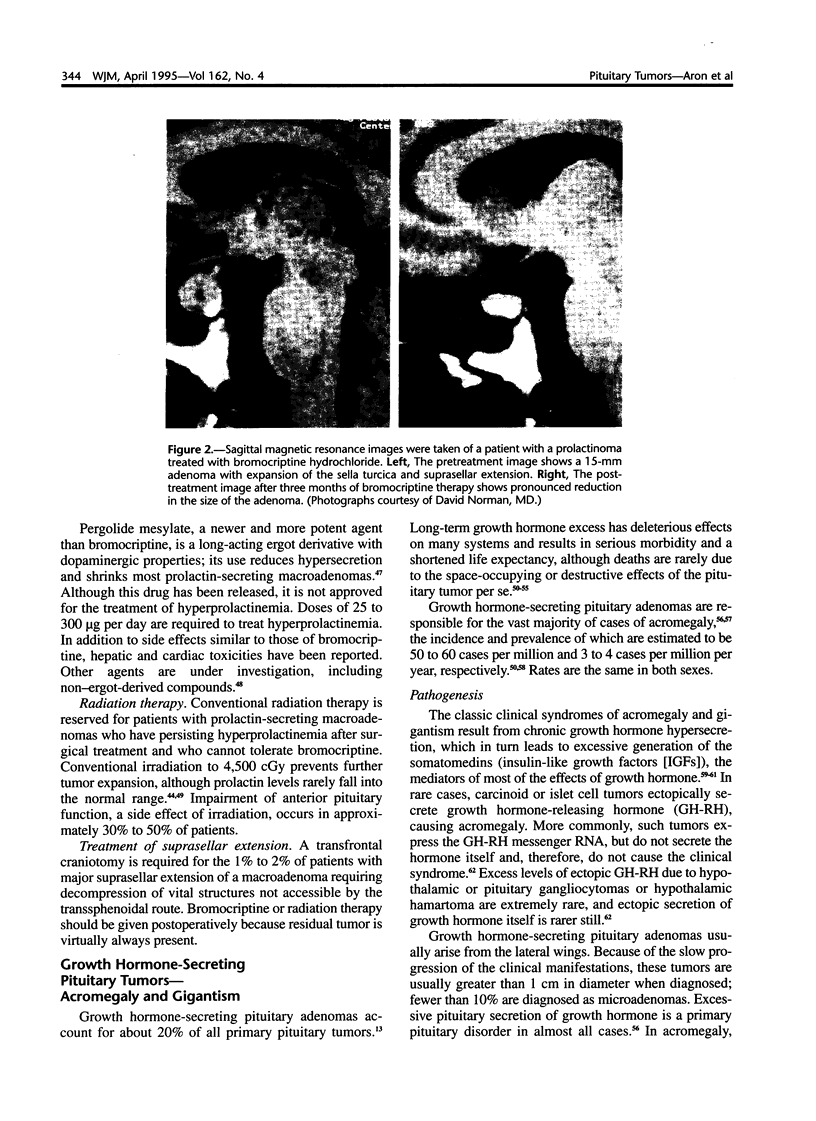
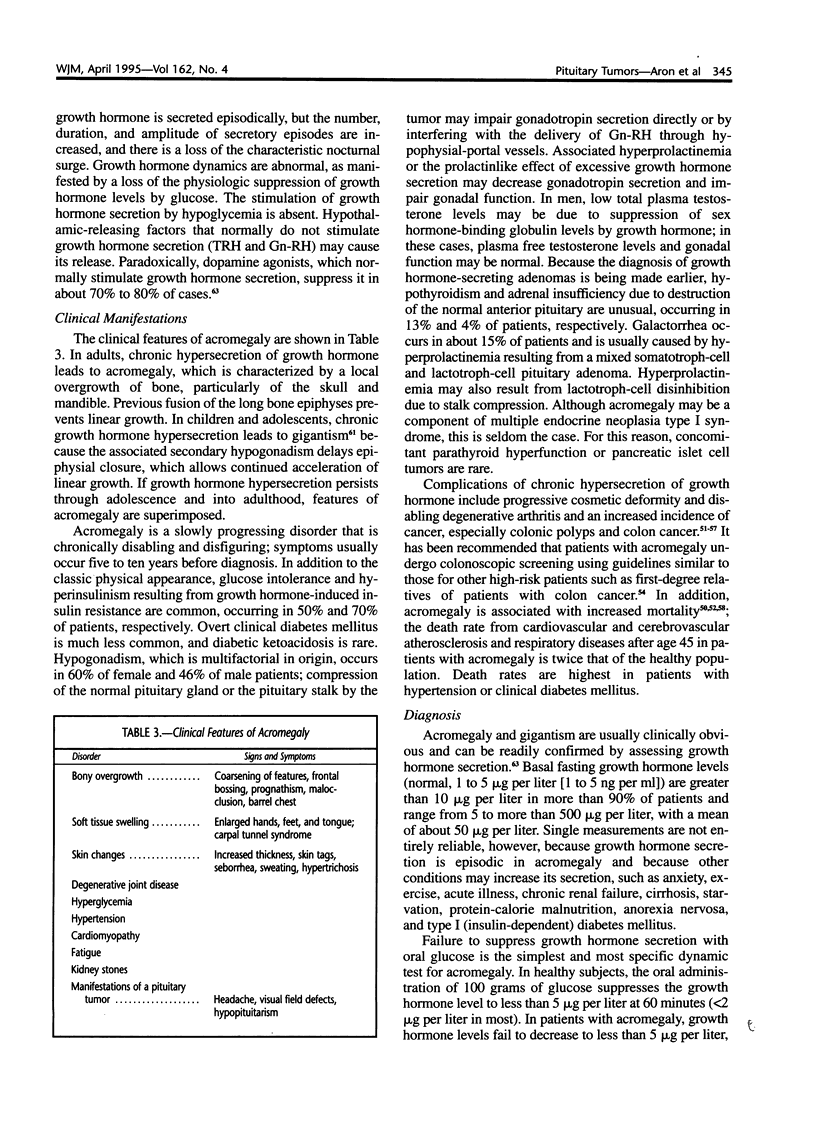
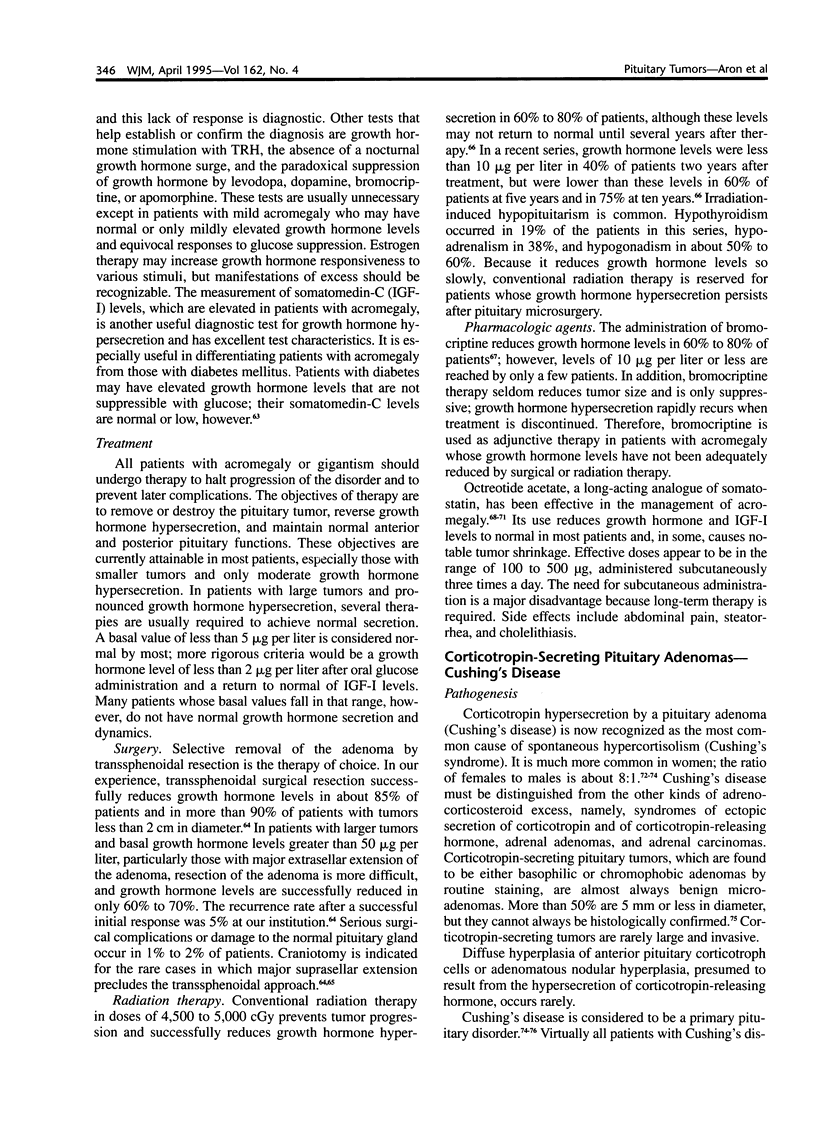
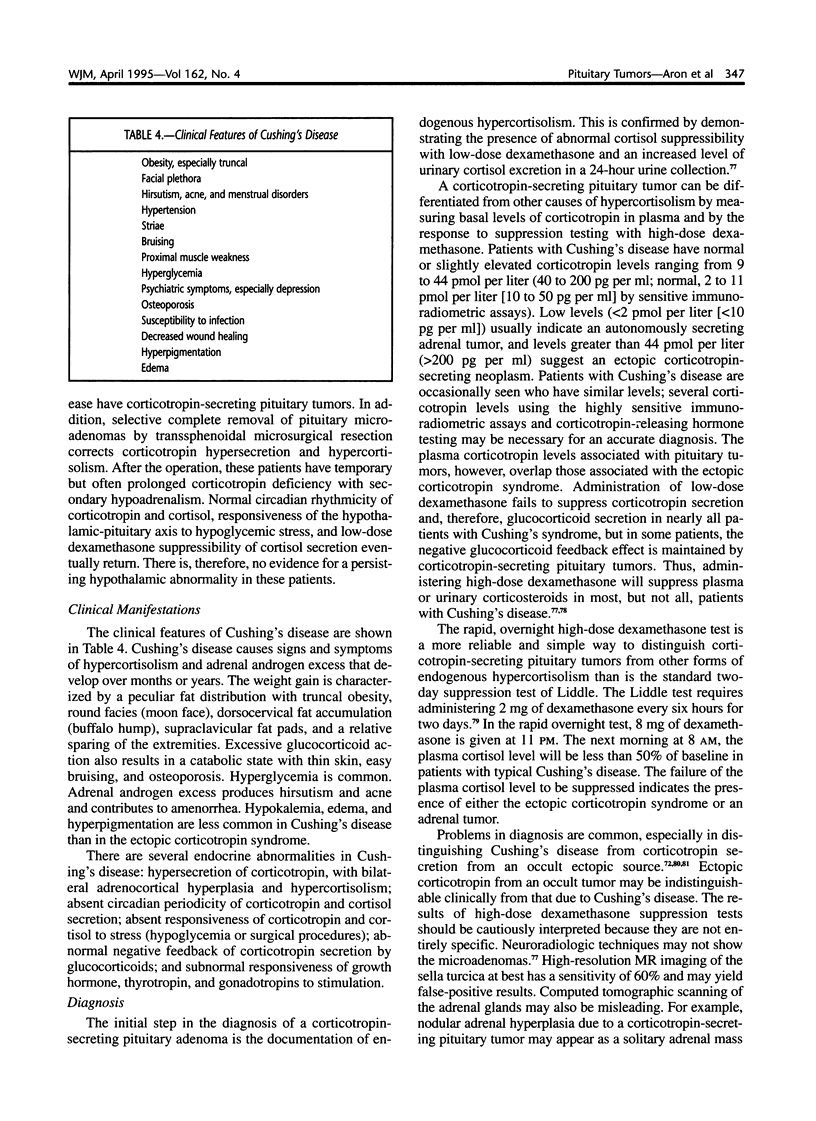
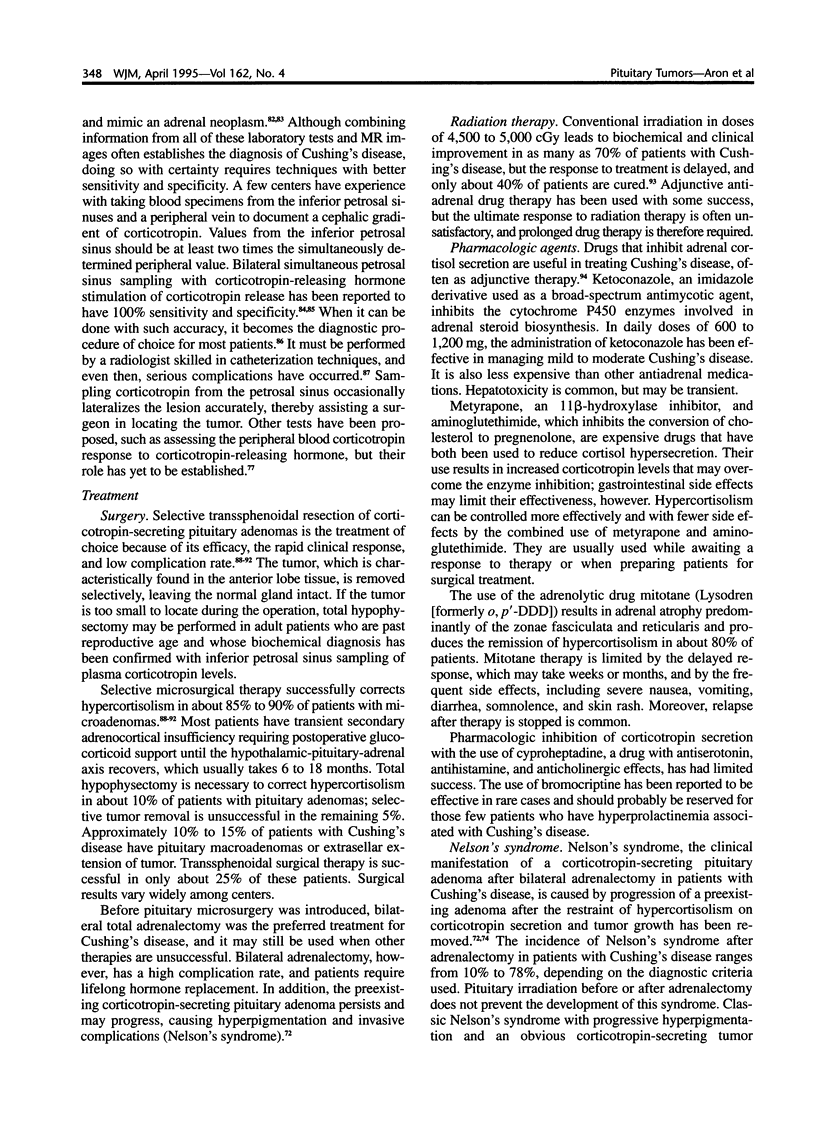
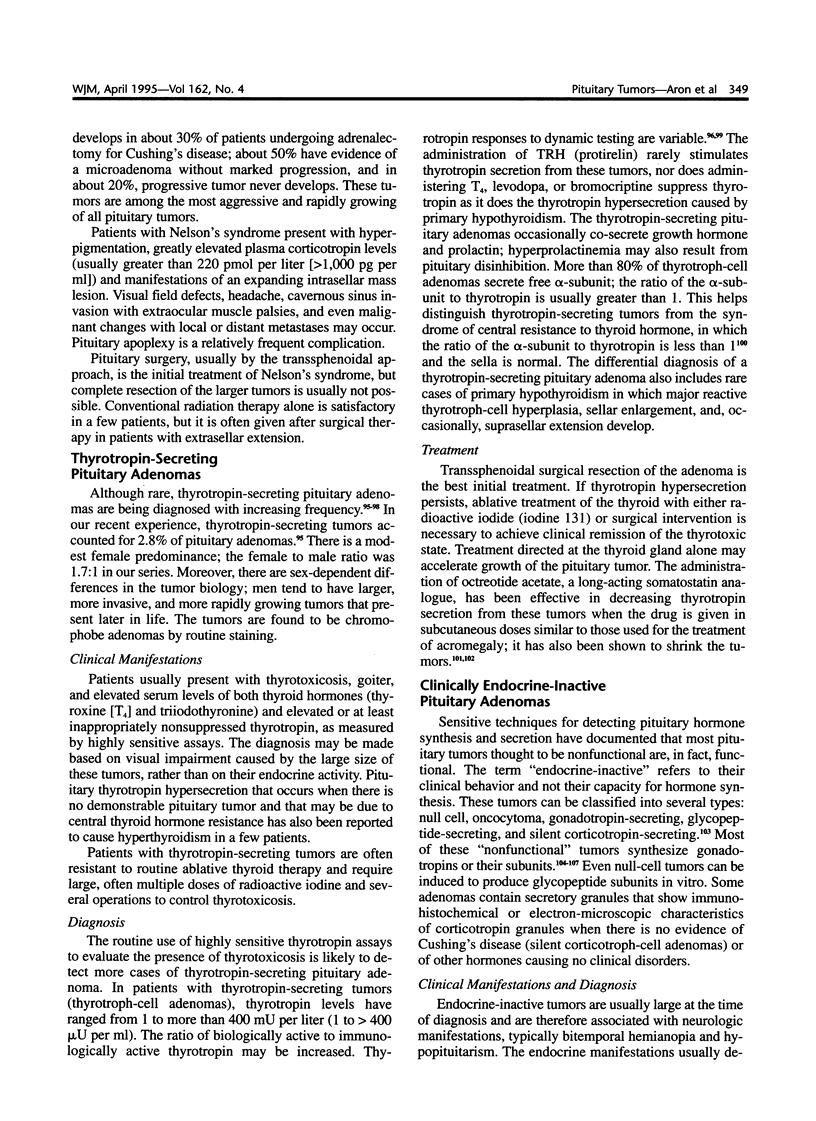
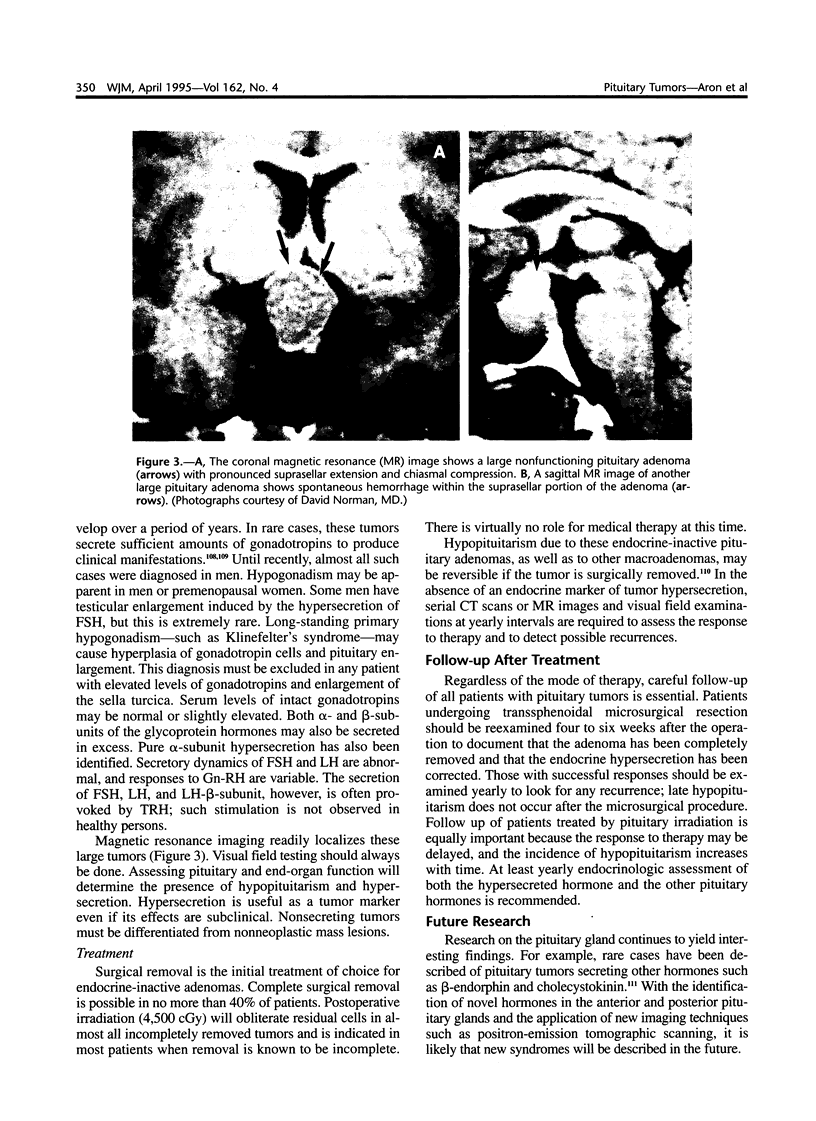
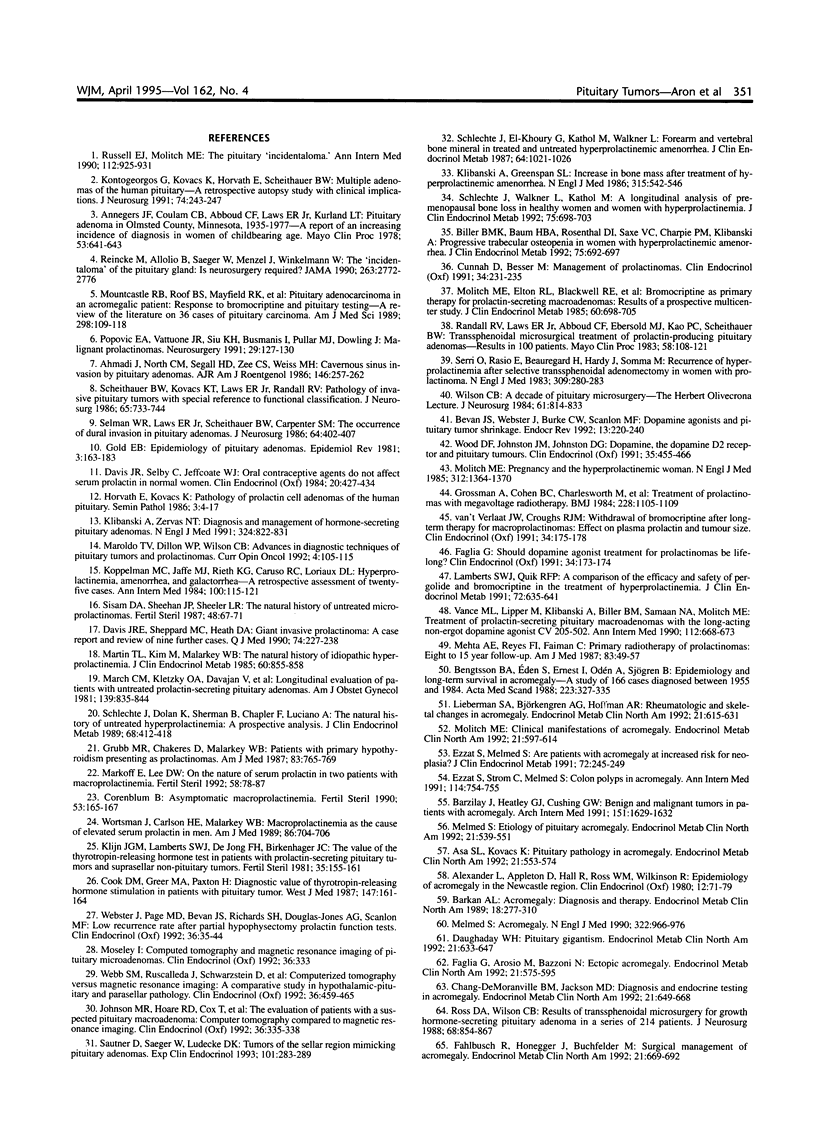
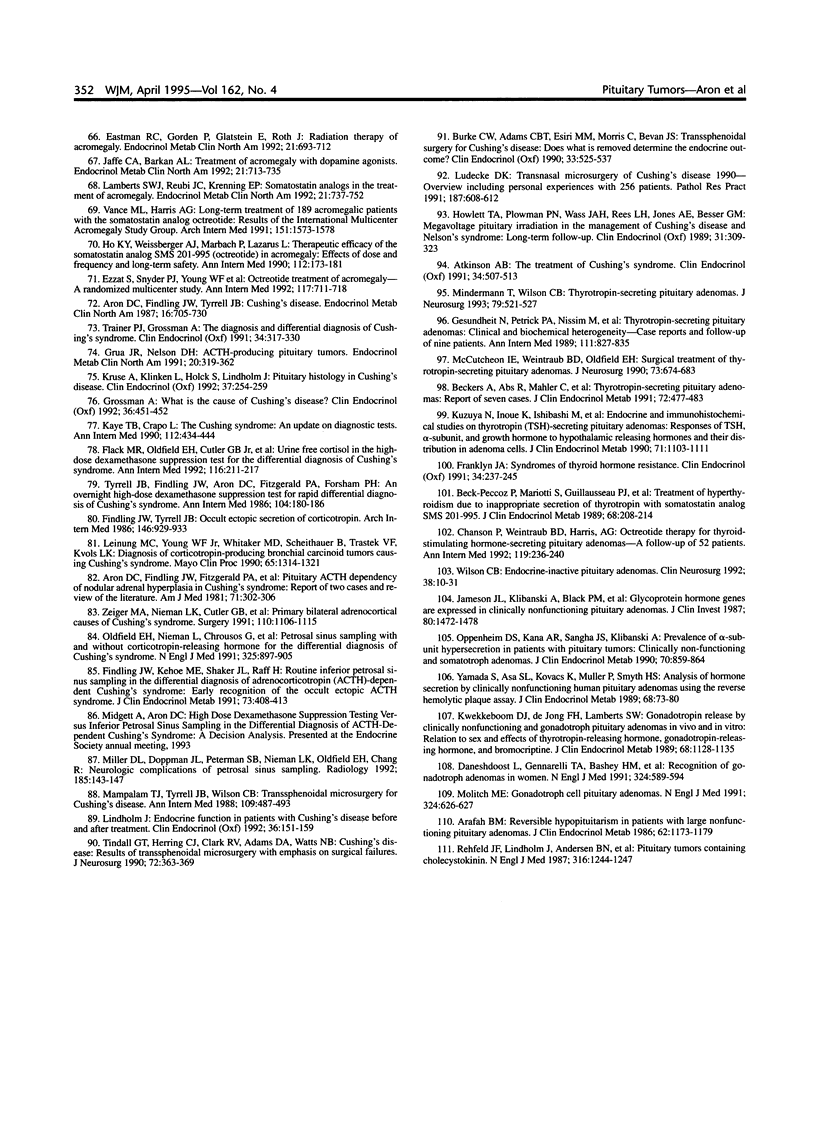
Images in this article
Selected References
These references are in PubMed. This may not be the complete list of references from this article.
- Ahmadi J., North C. M., Segall H. D., Zee C. S., Weiss M. H. Cavernous sinus invasion by pituitary adenomas. AJR Am J Roentgenol. 1986 Feb;146(2):257–262. doi: 10.2214/ajr.146.2.257. [DOI] [PubMed] [Google Scholar]
- Alexander L., Appleton D., Hall R., Ross W. M., Wilkinson R. Epidemiology of acromegaly in the Newcastle region. Clin Endocrinol (Oxf) 1980 Jan;12(1):71–79. doi: 10.1111/j.1365-2265.1980.tb03135.x. [DOI] [PubMed] [Google Scholar]
- Annegers J. F., Coulam C. B., Abboud C. F., Laws E. R., Jr, Kurland L. T. Pituitary adenoma in Olmsted County, Minnesota, 1935--1977. A report of an increasing incidence of diagnosis in women of childbearing age. Mayo Clin Proc. 1978 Oct;53(10):641–643. [PubMed] [Google Scholar]
- Arafah B. M. Reversible hypopituitarism in patients with large nonfunctioning pituitary adenomas. J Clin Endocrinol Metab. 1986 Jun;62(6):1173–1179. doi: 10.1210/jcem-62-6-1173. [DOI] [PubMed] [Google Scholar]
- Aron D. C., Findling J. W., Fitzgerald P. A., Brooks R. M., Fisher F. E., Forsham P. H., Tyrrell J. B. Pituitary ACTH dependency of nodular adrenal hyperplasia in Cushing's syndrome. Report of two cases and review of the literature. Am J Med. 1981 Aug;71(2):302–306. doi: 10.1016/0002-9343(81)90132-7. [DOI] [PubMed] [Google Scholar]
- Aron D. C., Findling J. W., Tyrrell J. B. Cushing's disease. Endocrinol Metab Clin North Am. 1987 Sep;16(3):705–730. [PubMed] [Google Scholar]
- Asa S. L., Kovacs K. Pituitary pathology in acromegaly. Endocrinol Metab Clin North Am. 1992 Sep;21(3):553–574. [PubMed] [Google Scholar]
- Atkinson A. B. The treatment of Cushing's syndrome. Clin Endocrinol (Oxf) 1991 Jun;34(6):507–513. doi: 10.1111/j.1365-2265.1991.tb00332.x. [DOI] [PubMed] [Google Scholar]
- Barkan A. L. Acromegaly. Diagnosis and therapy. Endocrinol Metab Clin North Am. 1989 Jun;18(2):277–310. [PubMed] [Google Scholar]
- Barzilay J., Heatley G. J., Cushing G. W. Benign and malignant tumors in patients with acromegaly. Arch Intern Med. 1991 Aug;151(8):1629–1632. [PubMed] [Google Scholar]
- Beck-Peccoz P., Mariotti S., Guillausseau P. J., Medri G., Piscitelli G., Bertoli A., Barbarino A., Rondena M., Chanson P., Pinchera A. Treatment of hyperthyroidism due to inappropriate secretion of thyrotropin with the somatostatin analog SMS 201-995. J Clin Endocrinol Metab. 1989 Jan;68(1):208–214. doi: 10.1210/jcem-68-1-208. [DOI] [PubMed] [Google Scholar]
- Beckers A., Abs R., Mahler C., Vandalem J. L., Pirens G., Hennen G., Stevenaert A. Thyrotropin-secreting pituitary adenomas: report of seven cases. J Clin Endocrinol Metab. 1991 Feb;72(2):477–483. doi: 10.1210/jcem-72-2-477. [DOI] [PubMed] [Google Scholar]
- Bengtsson B. A., Edén S., Ernest I., Odén A., Sjögren B. Epidemiology and long-term survival in acromegaly. A study of 166 cases diagnosed between 1955 and 1984. Acta Med Scand. 1988;223(4):327–335. doi: 10.1111/j.0954-6820.1988.tb15881.x. [DOI] [PubMed] [Google Scholar]
- Bevan J. S., Webster J., Burke C. W., Scanlon M. F. Dopamine agonists and pituitary tumor shrinkage. Endocr Rev. 1992 May;13(2):220–240. doi: 10.1210/edrv-13-2-220. [DOI] [PubMed] [Google Scholar]
- Biller B. M., Baum H. B., Rosenthal D. I., Saxe V. C., Charpie P. M., Klibanski A. Progressive trabecular osteopenia in women with hyperprolactinemic amenorrhea. J Clin Endocrinol Metab. 1992 Sep;75(3):692–697. doi: 10.1210/jcem.75.3.1517356. [DOI] [PubMed] [Google Scholar]
- Burke C. W., Adams C. B., Esiri M. M., Morris C., Bevan J. S. Transsphenoidal surgery for Cushing's disease: does what is removed determine the endocrine outcome? Clin Endocrinol (Oxf) 1990 Oct;33(4):525–537. doi: 10.1111/j.1365-2265.1990.tb03890.x. [DOI] [PubMed] [Google Scholar]
- Carlson H. E., Markoff E., Lee D. W. On the nature of serum prolactin in two patients with macroprolactinemia. Fertil Steril. 1992 Jul;58(1):78–87. [PubMed] [Google Scholar]
- Chang-DeMoranville B. M., Jackson I. M. Diagnosis and endocrine testing in acromegaly. Endocrinol Metab Clin North Am. 1992 Sep;21(3):649–668. [PubMed] [Google Scholar]
- Chanson P., Weintraub B. D., Harris A. G. Octreotide therapy for thyroid-stimulating hormone-secreting pituitary adenomas. A follow-up of 52 patients. Ann Intern Med. 1993 Aug 1;119(3):236–240. doi: 10.7326/0003-4819-119-3-199308010-00010. [DOI] [PubMed] [Google Scholar]
- Cook D. M., Greer M. A., Paxton H. Diagnostic value of thyrotropin-releasing-hormone stimulation in patients with pituitary tumor. West J Med. 1987 Aug;147(2):161–164. [PMC free article] [PubMed] [Google Scholar]
- Corenblum B. Asymptomatic hyperprolactinemia resulting from macroprolactinemia. Fertil Steril. 1990 Jan;53(1):165–167. doi: 10.1016/s0015-0282(16)53235-x. [DOI] [PubMed] [Google Scholar]
- Cunnah D., Besser M. Management of prolactinomas. Clin Endocrinol (Oxf) 1991 Mar;34(3):231–235. doi: 10.1111/j.1365-2265.1991.tb00299.x. [DOI] [PubMed] [Google Scholar]
- Daneshdoost L., Gennarelli T. A., Bashey H. M., Savino P. J., Sergott R. C., Bosley T. M., Snyder P. J. Recognition of gonadotroph adenomas in women. N Engl J Med. 1991 Feb 28;324(9):589–594. doi: 10.1056/NEJM199102283240904. [DOI] [PubMed] [Google Scholar]
- Daughaday W. H. Pituitary gigantism. Endocrinol Metab Clin North Am. 1992 Sep;21(3):633–647. [PubMed] [Google Scholar]
- Davis J. R., Selby C., Jeffcoate W. J. Oral contraceptive agents do not affect serum prolactin in normal women. Clin Endocrinol (Oxf) 1984 Apr;20(4):427–434. doi: 10.1111/j.1365-2265.1984.tb03438.x. [DOI] [PubMed] [Google Scholar]
- Davis J. R., Sheppard M. C., Heath D. A. Giant invasive prolactinoma: a case report and review of nine further cases. Q J Med. 1990 Mar;74(275):227–238. [PubMed] [Google Scholar]
- Eastman R. C., Gorden P., Glatstein E., Roth J. Radiation therapy of acromegaly. Endocrinol Metab Clin North Am. 1992 Sep;21(3):693–712. [PubMed] [Google Scholar]
- Ezzat S., Melmed S. Clinical review 18: Are patients with acromegaly at increased risk for neoplasia? J Clin Endocrinol Metab. 1991 Feb;72(2):245–249. doi: 10.1210/jcem-72-2-245. [DOI] [PubMed] [Google Scholar]
- Ezzat S., Snyder P. J., Young W. F., Boyajy L. D., Newman C., Klibanski A., Molitch M. E., Boyd A. E., Sheeler L., Cook D. M. Octreotide treatment of acromegaly. A randomized, multicenter study. Ann Intern Med. 1992 Nov 1;117(9):711–718. doi: 10.7326/0003-4819-117-9-711. [DOI] [PubMed] [Google Scholar]
- Ezzat S., Strom C., Melmed S. Colon polyps in acromegaly. Ann Intern Med. 1991 May 1;114(9):754–755. doi: 10.7326/0003-4819-114-9-754. [DOI] [PubMed] [Google Scholar]
- Faglia G., Arosio M., Bazzoni N. Ectopic acromegaly. Endocrinol Metab Clin North Am. 1992 Sep;21(3):575–595. [PubMed] [Google Scholar]
- Faglia G. Should dopamine agonist treatment for prolactinomas be life-long? Clin Endocrinol (Oxf) 1991 Mar;34(3):173–174. doi: 10.1111/j.1365-2265.1991.tb00288.x. [DOI] [PubMed] [Google Scholar]
- Fahlbusch R., Honegger J., Buchfelder M. Surgical management of acromegaly. Endocrinol Metab Clin North Am. 1992 Sep;21(3):669–692. [PubMed] [Google Scholar]
- Findling J. W., Kehoe M. E., Shaker J. L., Raff H. Routine inferior petrosal sinus sampling in the differential diagnosis of adrenocorticotropin (ACTH)-dependent Cushing's syndrome: early recognition of the occult ectopic ACTH syndrome. J Clin Endocrinol Metab. 1991 Aug;73(2):408–413. doi: 10.1210/jcem-73-2-408. [DOI] [PubMed] [Google Scholar]
- Findling J. W., Tyrrell J. B. Occult ectopic secretion of corticotropin. Arch Intern Med. 1986 May;146(5):929–933. [PubMed] [Google Scholar]
- Flack M. R., Oldfield E. H., Cutler G. B., Jr, Zweig M. H., Malley J. D., Chrousos G. P., Loriaux D. L., Nieman L. K. Urine free cortisol in the high-dose dexamethasone suppression test for the differential diagnosis of the Cushing syndrome. Ann Intern Med. 1992 Feb 1;116(3):211–217. doi: 10.7326/0003-4819-116-3-211. [DOI] [PubMed] [Google Scholar]
- Franklyn J. A. Syndromes of thyroid hormone resistance. Clin Endocrinol (Oxf) 1991 Mar;34(3):237–245. doi: 10.1111/j.1365-2265.1991.tb00300.x. [DOI] [PubMed] [Google Scholar]
- Gesundheit N., Petrick P. A., Nissim M., Dahlberg P. A., Doppman J. L., Emerson C. H., Braverman L. E., Oldfield E. H., Weintraub B. D. Thyrotropin-secreting pituitary adenomas: clinical and biochemical heterogeneity. Case reports and follow-up of nine patients. Ann Intern Med. 1989 Nov 15;111(10):827–835. doi: 10.7326/0003-4819-111-10-827. [DOI] [PubMed] [Google Scholar]
- Gold E. B. Epidemiology of pituitary adenomas. Epidemiol Rev. 1981;3:163–183. doi: 10.1093/oxfordjournals.epirev.a036232. [DOI] [PubMed] [Google Scholar]
- Grossman A., Cohen B. L., Charlesworth M., Plowman P. N., Rees L. H., Wass J. A., Jones A. E., Besser G. M. Treatment of prolactinomas with megavoltage radiotherapy. Br Med J (Clin Res Ed) 1984 Apr 14;288(6424):1105–1109. doi: 10.1136/bmj.288.6424.1105. [DOI] [PMC free article] [PubMed] [Google Scholar]
- Grossman A. What is the cause of Cushing's disease? Clin Endocrinol (Oxf) 1992 May;36(5):451–452. doi: 10.1111/j.1365-2265.1992.tb02244.x. [DOI] [PubMed] [Google Scholar]
- Grua J. R., Nelson D. H. ACTH-producing pituitary tumors. Endocrinol Metab Clin North Am. 1991 Jun;20(2):319–362. [PubMed] [Google Scholar]
- Grubb M. R., Chakeres D., Malarkey W. B. Patients with primary hypothyroidism presenting as prolactinomas. Am J Med. 1987 Oct;83(4):765–769. doi: 10.1016/0002-9343(87)90911-9. [DOI] [PubMed] [Google Scholar]
- Ho K. Y., Weissberger A. J., Marbach P., Lazarus L. Therapeutic efficacy of the somatostatin analog SMS 201-995 (octreotide) in acromegaly. Effects of dose and frequency and long-term safety. Ann Intern Med. 1990 Feb 1;112(3):173–181. doi: 10.7326/0003-4819-112-3-173. [DOI] [PubMed] [Google Scholar]
- Horvath E., Kovacs K. Pathology of prolactin cell adenomas of the human pituitary. Semin Diagn Pathol. 1986 Feb;3(1):4–17. [PubMed] [Google Scholar]
- Howlett T. A., Plowman P. N., Wass J. A., Rees L. H., Jones A. E., Besser G. M. Megavoltage pituitary irradiation in the management of Cushing's disease and Nelson's syndrome: long-term follow-up. Clin Endocrinol (Oxf) 1989 Sep;31(3):309–323. doi: 10.1111/j.1365-2265.1989.tb01255.x. [DOI] [PubMed] [Google Scholar]
- Jaffe C. A., Barkan A. L. Treatment of acromegaly with dopamine agonists. Endocrinol Metab Clin North Am. 1992 Sep;21(3):713–735. [PubMed] [Google Scholar]
- Jameson J. L., Klibanski A., Black P. M., Zervas N. T., Lindell C. M., Hsu D. W., Ridgway E. C., Habener J. F. Glycoprotein hormone genes are expressed in clinically nonfunctioning pituitary adenomas. J Clin Invest. 1987 Nov;80(5):1472–1478. doi: 10.1172/JCI113228. [DOI] [PMC free article] [PubMed] [Google Scholar]
- Johnson M. R., Hoare R. D., Cox T., Dawson J. M., Maccabe J. J., Llewelyn D. E., McGregor A. M. The evaluation of patients with a suspected pituitary microadenoma: computer tomography compared to magnetic resonance imaging. Clin Endocrinol (Oxf) 1992 Apr;36(4):335–338. doi: 10.1111/j.1365-2265.1992.tb01456.x. [DOI] [PubMed] [Google Scholar]
- Kaye T. B., Crapo L. The Cushing syndrome: an update on diagnostic tests. Ann Intern Med. 1990 Mar 15;112(6):434–444. doi: 10.7326/0003-4819-76-3-112-6-434. [DOI] [PubMed] [Google Scholar]
- Klibanski A., Greenspan S. L. Increase in bone mass after treatment of hyperprolactinemic amenorrhea. N Engl J Med. 1986 Aug 28;315(9):542–546. doi: 10.1056/NEJM198608283150903. [DOI] [PubMed] [Google Scholar]
- Klibanski A., Zervas N. T. Diagnosis and management of hormone-secreting pituitary adenomas. N Engl J Med. 1991 Mar 21;324(12):822–831. doi: 10.1056/NEJM199103213241207. [DOI] [PubMed] [Google Scholar]
- Klijn J. G., Lamberts S. W., de Jong F. H., Birkenhäger J. C. The value of the thyrotropin-releasing hormone test in patients with prolactin-secreting pituitary tumors and suprasellar non-pituitary tumors. Fertil Steril. 1981 Feb;35(2):155–161. doi: 10.1016/s0015-0282(16)45315-x. [DOI] [PubMed] [Google Scholar]
- Kontogeorgos G., Kovacs K., Horvath E., Scheithauer B. W. Multiple adenomas of the human pituitary. A retrospective autopsy study with clinical implications. J Neurosurg. 1991 Feb;74(2):243–247. doi: 10.3171/jns.1991.74.2.0243. [DOI] [PubMed] [Google Scholar]
- Koppelman M. C., Jaffe M. J., Rieth K. G., Caruso R. C., Loriaux D. L. Hyperprolactinemia, amenorrhea, and galactorrhea. A retrospective assessment of twenty-five cases. Ann Intern Med. 1984 Jan;100(1):115–121. doi: 10.7326/0003-4819-100-1-115. [DOI] [PubMed] [Google Scholar]
- Kruse A., Klinken L., Holck S., Lindholm J. Pituitary histology in Cushing's disease. Clin Endocrinol (Oxf) 1992 Sep;37(3):254–259. doi: 10.1111/j.1365-2265.1992.tb02319.x. [DOI] [PubMed] [Google Scholar]
- Kuzuya N., Inoue K., Ishibashi M., Murayama Y., Koide Y., Ito K., Yamaji T., Yamashita K. Endocrine and immunohistochemical studies on thyrotropin (TSH)-secreting pituitary adenomas: responses of TSH, alpha-subunit, and growth hormone to hypothalamic releasing hormones and their distribution in adenoma cells. J Clin Endocrinol Metab. 1990 Nov;71(5):1103–1111. doi: 10.1210/jcem-71-5-1103. [DOI] [PubMed] [Google Scholar]
- Kwekkeboom D. J., de Jong F. H., Lamberts S. W. Gonadotropin release by clinically nonfunctioning and gonadotroph pituitary adenomas in vivo and in vitro: relation to sex and effects of thyrotropin-releasing hormone, gonadotropin-releasing hormone, and bromocriptine. J Clin Endocrinol Metab. 1989 Jun;68(6):1128–1135. doi: 10.1210/jcem-68-6-1128. [DOI] [PubMed] [Google Scholar]
- Lamberts S. W., Quik R. F. A comparison of the efficacy and safety of pergolide and bromocriptine in the treatment of hyperprolactinemia. J Clin Endocrinol Metab. 1991 Mar;72(3):635–641. doi: 10.1210/jcem-72-3-635. [DOI] [PubMed] [Google Scholar]
- Lamberts S. W., Reubi J. C., Krenning E. P. Somatostatin analogs in the treatment of acromegaly. Endocrinol Metab Clin North Am. 1992 Sep;21(3):737–752. [PubMed] [Google Scholar]
- Leinung M. C., Young W. F., Jr, Whitaker M. D., Scheithauer B. W., Trastek V. F., Kvols L. K. Diagnosis of corticotropin-producing bronchial carcinoid tumors causing Cushing's syndrome. Mayo Clin Proc. 1990 Oct;65(10):1314–1321. doi: 10.1016/s0025-6196(12)62142-9. [DOI] [PubMed] [Google Scholar]
- Lieberman S. A., Björkengren A. G., Hoffman A. R. Rheumatologic and skeletal changes in acromegaly. Endocrinol Metab Clin North Am. 1992 Sep;21(3):615–631. [PubMed] [Google Scholar]
- Lindholm J. Endocrine function in patients with Cushing's disease before and after treatment. Clin Endocrinol (Oxf) 1992 Feb;36(2):151–159. doi: 10.1111/j.1365-2265.1992.tb00950.x. [DOI] [PubMed] [Google Scholar]
- Lüdecke D. K. Transnasal microsurgery of Cushing's disease 1990. Overview including personal experiences with 256 patients. Pathol Res Pract. 1991 Jun;187(5):608–612. doi: 10.1016/S0344-0338(11)80155-X. [DOI] [PubMed] [Google Scholar]
- Mampalam T. J., Tyrrell J. B., Wilson C. B. Transsphenoidal microsurgery for Cushing disease. A report of 216 cases. Ann Intern Med. 1988 Sep 15;109(6):487–493. doi: 10.7326/0003-4819-109-6-487. [DOI] [PubMed] [Google Scholar]
- March C. M., Kletzky O. A., Davajan V., Teal J., Weiss M., Apuzzo M. L., Marrs R. P., Mishell D. R., Jr Longitudinal evaluation of patients with untreated prolactin-secreting pituitary adenomas. Am J Obstet Gynecol. 1981 Apr 1;139(7):835–844. doi: 10.1016/0002-9378(81)90553-6. [DOI] [PubMed] [Google Scholar]
- Maroldo T. V., Dillon W. P., Wilson C. B. Advances in diagnostic techniques of pituitary tumors and prolactinomas. Curr Opin Oncol. 1992 Feb;4(1):105–115. doi: 10.1097/00001622-199202000-00014. [DOI] [PubMed] [Google Scholar]
- Martin T. L., Kim M., Malarkey W. B. The natural history of idiopathic hyperprolactinemia. J Clin Endocrinol Metab. 1985 May;60(5):855–858. doi: 10.1210/jcem-60-5-855. [DOI] [PubMed] [Google Scholar]
- McCutcheon I. E., Weintraub B. D., Oldfield E. H. Surgical treatment of thyrotropin-secreting pituitary adenomas. J Neurosurg. 1990 Nov;73(5):674–683. doi: 10.3171/jns.1990.73.5.0674. [DOI] [PubMed] [Google Scholar]
- Mehta A. E., Reyes F. I., Faiman C. Primary radiotherapy of prolactinomas. Eight- to 15-year follow-up. Am J Med. 1987 Jul;83(1):49–58. doi: 10.1016/0002-9343(87)90496-7. [DOI] [PubMed] [Google Scholar]
- Melmed S. Acromegaly. N Engl J Med. 1990 Apr 5;322(14):966–977. doi: 10.1056/NEJM199004053221405. [DOI] [PubMed] [Google Scholar]
- Melmed S. Etiology of pituitary acromegaly. Endocrinol Metab Clin North Am. 1992 Sep;21(3):539–551. [PubMed] [Google Scholar]
- Miller D. L., Doppman J. L., Peterman S. B., Nieman L. K., Oldfield E. H., Chang R. Neurologic complications of petrosal sinus sampling. Radiology. 1992 Oct;185(1):143–147. doi: 10.1148/radiology.185.1.1523298. [DOI] [PubMed] [Google Scholar]
- Mindermann T., Wilson C. B. Thyrotropin-producing pituitary adenomas. J Neurosurg. 1993 Oct;79(4):521–527. doi: 10.3171/jns.1993.79.4.0521. [DOI] [PubMed] [Google Scholar]
- Molitch M. E. Clinical manifestations of acromegaly. Endocrinol Metab Clin North Am. 1992 Sep;21(3):597–614. [PubMed] [Google Scholar]
- Molitch M. E., Elton R. L., Blackwell R. E., Caldwell B., Chang R. J., Jaffe R., Joplin G., Robbins R. J., Tyson J., Thorner M. O. Bromocriptine as primary therapy for prolactin-secreting macroadenomas: results of a prospective multicenter study. J Clin Endocrinol Metab. 1985 Apr;60(4):698–705. doi: 10.1210/jcem-60-4-698. [DOI] [PubMed] [Google Scholar]
- Molitch M. E. Gonadotroph-cell pituitary adenomas. N Engl J Med. 1991 Feb 28;324(9):626–627. doi: 10.1056/NEJM199102283240909. [DOI] [PubMed] [Google Scholar]
- Molitch M. E. Pregnancy and the hyperprolactinemic woman. N Engl J Med. 1985 May 23;312(21):1364–1370. doi: 10.1056/NEJM198505233122106. [DOI] [PubMed] [Google Scholar]
- Molitch M. E., Russell E. J. The pituitary "incidentaloma". Ann Intern Med. 1990 Jun 15;112(12):925–931. doi: 10.7326/0003-4819-112-12-925. [DOI] [PubMed] [Google Scholar]
- Moseley I. Computed tomography and magnetic resonance imaging of pituitary microadenomas. Clin Endocrinol (Oxf) 1992 Apr;36(4):333–333. doi: 10.1111/j.1365-2265.1992.tb01455.x. [DOI] [PubMed] [Google Scholar]
- Mountcastle R. B., Roof B. S., Mayfield R. K., Mordes D. B., Sagel J., Biggs P. J., Rawe S. E. Pituitary adenocarcinoma in an acromegalic patient: response to bromocriptine and pituitary testing: a review of the literature on 36 cases of pituitary carcinoma. Am J Med Sci. 1989 Aug;298(2):109–118. doi: 10.1097/00000441-198908000-00007. [DOI] [PubMed] [Google Scholar]
- Oldfield E. H., Doppman J. L., Nieman L. K., Chrousos G. P., Miller D. L., Katz D. A., Cutler G. B., Jr, Loriaux D. L. Petrosal sinus sampling with and without corticotropin-releasing hormone for the differential diagnosis of Cushing's syndrome. N Engl J Med. 1991 Sep 26;325(13):897–905. doi: 10.1056/NEJM199109263251301. [DOI] [PubMed] [Google Scholar]
- Oppenheim D. S., Kana A. R., Sangha J. S., Klibanski A. Prevalence of alpha-subunit hypersecretion in patients with pituitary tumors: clinically nonfunctioning and somatotroph adenomas. J Clin Endocrinol Metab. 1990 Apr;70(4):859–864. doi: 10.1210/jcem-70-4-859. [DOI] [PubMed] [Google Scholar]
- Popovic E. A., Vattuone J. R., Siu K. H., Busmanis I., Pullar M. J., Dowling J. Malignant prolactinomas. Neurosurgery. 1991 Jul;29(1):127–130. doi: 10.1097/00006123-199107000-00023. [DOI] [PubMed] [Google Scholar]
- Randall R. V., Laws E. R., Jr, Abboud C. F., Ebersold M. J., Kao P. C., Scheithauer B. W. Transsphenoidal microsurgical treatment of prolactin-producing pituitary adenomas. Results in 100 patients. Mayo Clin Proc. 1983 Feb;58(2):108–121. [PubMed] [Google Scholar]
- Rehfeld J. F., Lindholm J., Andersen B. N., Bardram L., Cantor P., Fenger M., Lüdecke D. K. Pituitary tumors containing cholecystokinin. N Engl J Med. 1987 May 14;316(20):1244–1247. doi: 10.1056/NEJM198705143162004. [DOI] [PubMed] [Google Scholar]
- Reincke M., Allolio B., Saeger W., Menzel J., Winkelmann W. The 'incidentaloma' of the pituitary gland. Is neurosurgery required? JAMA. 1990 May 23;263(20):2772–2776. [PubMed] [Google Scholar]
- Ross D. A., Wilson C. B. Results of transsphenoidal microsurgery for growth hormone-secreting pituitary adenoma in a series of 214 patients. J Neurosurg. 1988 Jun;68(6):854–867. doi: 10.3171/jns.1988.68.6.0854. [DOI] [PubMed] [Google Scholar]
- Sautner D., Saeger W., Lüdecke D. K. Tumors of the sellar region mimicking pituitary adenomas. Exp Clin Endocrinol. 1993;101(5):283–289. doi: 10.1055/s-0029-1211245. [DOI] [PubMed] [Google Scholar]
- Scheithauer B. W., Kovacs K. T., Laws E. R., Jr, Randall R. V. Pathology of invasive pituitary tumors with special reference to functional classification. J Neurosurg. 1986 Dec;65(6):733–744. doi: 10.3171/jns.1986.65.6.0733. [DOI] [PubMed] [Google Scholar]
- Schlechte J., Dolan K., Sherman B., Chapler F., Luciano A. The natural history of untreated hyperprolactinemia: a prospective analysis. J Clin Endocrinol Metab. 1989 Feb;68(2):412–418. doi: 10.1210/jcem-68-2-412. [DOI] [PubMed] [Google Scholar]
- Schlechte J., Walkner L., Kathol M. A longitudinal analysis of premenopausal bone loss in healthy women and women with hyperprolactinemia. J Clin Endocrinol Metab. 1992 Sep;75(3):698–703. doi: 10.1210/jcem.75.3.1517357. [DOI] [PubMed] [Google Scholar]
- Schlechte J., el-Khoury G., Kathol M., Walkner L. Forearm and vertebral bone mineral in treated and untreated hyperprolactinemic amenorrhea. J Clin Endocrinol Metab. 1987 May;64(5):1021–1026. doi: 10.1210/jcem-64-5-1021. [DOI] [PubMed] [Google Scholar]
- Selman W. R., Laws E. R., Jr, Scheithauer B. W., Carpenter S. M. The occurrence of dural invasion in pituitary adenomas. J Neurosurg. 1986 Mar;64(3):402–407. doi: 10.3171/jns.1986.64.3.0402. [DOI] [PubMed] [Google Scholar]
- Serri O., Rasio E., Beauregard H., Hardy J., Somma M. Recurrence of hyperprolactinemia after selective transsphenoidal adenomectomy in women with prolactinoma. N Engl J Med. 1983 Aug 4;309(5):280–283. doi: 10.1056/NEJM198308043090505. [DOI] [PubMed] [Google Scholar]
- Sisam D. A., Sheehan J. P., Sheeler L. R. The natural history of untreated microprolactinomas. Fertil Steril. 1987 Jul;48(1):67–71. doi: 10.1016/s0015-0282(16)59292-9. [DOI] [PubMed] [Google Scholar]
- Tindall G. T., Herring C. J., Clark R. V., Adams D. A., Watts N. B. Cushing's disease: results of transsphenoidal microsurgery with emphasis on surgical failures. J Neurosurg. 1990 Mar;72(3):363–369. doi: 10.3171/jns.1990.72.3.0363. [DOI] [PubMed] [Google Scholar]
- Trainer P. J., Grossman A. The diagnosis and differential diagnosis of Cushing's syndrome. Clin Endocrinol (Oxf) 1991 Apr;34(4):317–330. doi: 10.1111/j.1365-2265.1991.tb03773.x. [DOI] [PubMed] [Google Scholar]
- Tyrrell J. B., Findling J. W., Aron D. C., Fitzgerald P. A., Forsham P. H. An overnight high-dose dexamethasone suppression test for rapid differential diagnosis of Cushing's syndrome. Ann Intern Med. 1986 Feb;104(2):180–186. doi: 10.7326/0003-4819-104-2-180. [DOI] [PubMed] [Google Scholar]
- Vance M. L., Harris A. G. Long-term treatment of 189 acromegalic patients with the somatostatin analog octreotide. Results of the International Multicenter Acromegaly Study Group. Arch Intern Med. 1991 Aug;151(8):1573–1578. [PubMed] [Google Scholar]
- Vance M. L., Lipper M., Klibanski A., Biller B. M., Samaan N. A., Molitch M. E. Treatment of prolactin-secreting pituitary macroadenomas with the long-acting non-ergot dopamine agonist CV 205-502. Ann Intern Med. 1990 May 1;112(9):668–673. doi: 10.7326/0003-4819-112-9-668. [DOI] [PubMed] [Google Scholar]
- Webb S. M., Ruscalleda J., Schwarzstein D., Calaf-Alsina J., Rovira A., Matos G., Puig-Domingo M., de Leiva A. Computerized tomography versus magnetic resonance imaging: a comparative study in hypothalamic-pituitary and parasellar pathology. Clin Endocrinol (Oxf) 1992 May;36(5):459–465. doi: 10.1111/j.1365-2265.1992.tb02246.x. [DOI] [PubMed] [Google Scholar]
- Webster J., Page M. D., Bevan J. S., Richards S. H., Douglas-Jones A. G., Scanlon M. F. Low recurrence rate after partial hypophysectomy for prolactinoma: the predictive value of dynamic prolactin function tests. Clin Endocrinol (Oxf) 1992 Jan;36(1):35–44. doi: 10.1111/j.1365-2265.1992.tb02900.x. [DOI] [PubMed] [Google Scholar]
- Wilson C. B. A decade of pituitary microsurgery. The Herbert Olivecrona lecture. J Neurosurg. 1984 Nov;61(5):814–833. doi: 10.3171/jns.1984.61.5.0814. [DOI] [PubMed] [Google Scholar]
- Wilson C. B. Endocrine-inactive pituitary adenomas. Clin Neurosurg. 1992;38:10–31. [PubMed] [Google Scholar]
- Wood D. F., Johnston J. M., Johnston D. G. Dopamine, the dopamine D2 receptor and pituitary tumours. Clin Endocrinol (Oxf) 1991 Dec;35(6):455–466. doi: 10.1111/j.1365-2265.1991.tb00928.x. [DOI] [PubMed] [Google Scholar]
- Wortsman J., Carlson H. E., Malarkey W. B. Macroprolactinemia as the cause of elevated serum prolactin in men. Am J Med. 1989 Jun;86(6 Pt 1):704–706. doi: 10.1016/0002-9343(89)90449-x. [DOI] [PubMed] [Google Scholar]
- Yamada S., Asa S. L., Kovacs K., Muller P., Smyth H. S. Analysis of hormone secretion by clinically nonfunctioning human pituitary adenomas using the reverse hemolytic plaque assay. J Clin Endocrinol Metab. 1989 Jan;68(1):73–80. doi: 10.1210/jcem-68-1-73. [DOI] [PubMed] [Google Scholar]
- Zeiger M. A., Nieman L. K., Cutler G. B., Chrousos G. P., Doppman J. L., Travis W. D., Norton J. A. Primary bilateral adrenocortical causes of Cushing's syndrome. Surgery. 1991 Dec;110(6):1106–1115. [PubMed] [Google Scholar]
- van 't Verlaat J. W., Croughs R. J. Withdrawal of bromocriptine after long-term therapy for macroprolactinomas; effect on plasma prolactin and tumour size. Clin Endocrinol (Oxf) 1991 Mar;34(3):175–178. doi: 10.1111/j.1365-2265.1991.tb00289.x. [DOI] [PubMed] [Google Scholar]





